-

新人教版高中英语必修2Unit 4 History and Traditions-Listening&Speaking&Talking教案一
This unit is about history and traditions. From the opening page, we can know that this unit will introduce the history and traditions around the world. As Marcus Garvey says “A people without the knowledge of their past history, origin and culture is like a tree without roots”, it is important for students to realize the importance and value of knowing the history and traditions and their further meanings. And this part ( listening and speaking ) is divided into two parts: Part A---share views on historic sites, Part B ---talk about a visit to a historic tourist destination. By talking with a foreigner, the speakers introduce the historic attractions and their cultures. Part A is that William, a British student, who was going to visit the Confucius Temple and a Chinese student, Xiao Kong, who was going to the Confucius Temple to meet with the members of the research group, went together and exchanged their views on the Confucius Temple, Confucius, Confucius' descendants and Confucius' educational thoughts. Part B is a conversation between Xiao Yan, a youth hostel receptionist and Paul, a backpacker about the feelings and experience after visiting the Chinese famous tourist attraction Pingyao.1. Guide students to understand the content of listening texts in terms of the whole and key details; 2. Cultivate students' ability to guess the meaning of words in listening; discuss with their peers how to talk about historic spots and great person.3. Instruct students to use functional sentences of showing one’s excitement, surprise and disappointment.1. Guide students to understand the content of listening texts in terms of the whole and key details; 2. Cultivate students' ability to discuss with their peers the related topics.3. Enable students to use the functional items of showing one’s excitement, surprise and disappointment.

新人教版高中英语必修2Unit 4 History and Traditions-Discovering Useful Structure教案二
This teaching period mainly deals with grammar: The past participle is used as attributive and objective complement.1. Guide students to review the basic usages of the past participle used as attributive and objective complement.2. Lead students to learn to use some special cases concerning the past participle used as attributive and objective complement flexibly.3. Strengthen students’ great interest in grammar learning.1. Help students to appreciate the function of the past participle used as attributive and objective complement.2. Instruct students to write essays using the past participle used as attributive and objective complement.Step1:温故而知新。Analyze the underlined phrases and then sum up the common usages of the past participles.1.(教材P41)They had castles built(build) all around England, and made changes to the legal system.2.(教材P42)They use the same flag, known(know) as the Union Jack,...3.(教材P42)Judy and I had our car parked(park) in an underground car park near Trafalgar Square, where we could get our car battery charged(charge).Common points: f the past participle used as attributive and objective complement.Step 2:过去分词作定语时的意义1.及物动词的过去分词作定语,在语态上表示被动;在时间上,常表示动作已经发生或完成,有时也不表示时间性。Our teacher watched us doing the experiment and gave us a satisfied smile at last.我们的老师看着我们做实验,最后给了我们一个满意的微笑。The plan put forward at the meeting will be carried out soon.会上提出的计划将很快被执行。2.不及物动词的过去分词作定语,它不表示被动意义,只强调动作完成。Many little kids like gathering fallen leaves in the yard.

新人教版高中英语必修2Unit 4 History and traditions教案
这个地区有着深厚的传统。既学既练:为了让更多的外国游客了解中国文化,欣赏中国美丽的自然风光,感受中国发生的巨大变化,某外文杂志社将出版一本英语小册子来介绍中国的旅游景点。该杂志社邀请你为该小册子写一篇英语短文来介绍杭州,内容包括:1.杭州的位置(中国东南部)、面积(16 000多平方公里)及历史(2 200多年)等;2.杭州的旅游特色(自然风景、传统文化、特色小吃等);3.希望更多的游客来杭州参观。注意:1.词数80左右;2.可适当增加细节,以使行文连贯。Located in the southeast of China, Hangzhou is a beautiful city.Dating back more than 2,200 years, Hangzhou covers an area of more than 16,000 square kilometers.In Hangzhou, you can visit the West Lake, whose scenery is fascinating.In addition, you can’t miss its cultural relics and historical sites, from which you will learn more about excellent Chinese traditional culture and traditions.In Hangzhou, the special snacks are famous and visitors from different parts of the world think highly of them.As a tourist attraction, Hangzhou attracts a large number of visitors from home and abroad every year.Once you come to China, Hangzhou is a scenic spot you can’t miss.

新人教版高中英语必修1Unit 2 Travelling Around-Discovering Useful Structure教案
(5)be to do (可以和具体的时间状语连用)①表示按计划、安排即将发生的动作。②用于时间、条件状语从句中,表示“如果要……,想要……”。The students are to meet at the school gate tomorrow. 明天学生们将在学校大门口集会。 If you are to succeed, you must work as hard as possible. 如果你想要成功,比必须努力工作。(6)be about to do (不与具体的时间状语连用) 表示即将要发生的动作。We are about to start. 我们就要出发了。The new school year is about to begin. 新学年开学在即。(7)一般现在时表将来①表示按时间表规定将要发生的动作。常限于表示位置移动的短暂性动词。②在时间、条件或让步状语从句中,用一般现在时表将来。Look at the timetable. Hurry up! Flight 4026 takes off at 18:20. 你看看时刻表,快点!4026次航班的起飞时间是下午6点20分。Jane is in a hurry because the train to the airport leaves in half an hour. 简很匆忙,因为去机场的火车半小时后出发。

新人教版高中英语必修2Unit 1 Cultural Heritage-Discovering Useful Structure教案一
This teaching period mainly deals with grammar “restrictive relative clauses.” To begin with, teachers should lead students to revise what they have learned about the relative pronouns and relative adverbs. And then, teachers move on to stress more special cases concerning this grammar, such as the “preposition+ relative pronouns which and whom” and cases where we can omit the relative pronouns. This period carries considerable significance to the cultivation of students’ writing competence and lays a solid foundation for the basic appreciation of language beauty. The teacher is expected to enable students to master this period thoroughly and consolidate the knowledge by doing some exercises. 1. Guide students to review the basic usages of relative pronouns and adverbs of attributive clauses.2. Lead students to learn to use some special cases concerning restrictive relative clauses flexibly.2. Enable students to use the basic phrases structures flexibly.3. Strengthen students’ great interest in grammar learning.1. Help students to appreciate the function of relative pronouns and adverbs of attributive clauses in a sentence2. Instruct students to write essays using the proper relative pronouns and adverbs of attributive clauses.本节语法思考:定语从句在复合句中的作用是什么? 关系词有哪些?定语从句在复合句中的作用相当于形容词,它在句中作定语修饰名词或代词。他们在先行词和定语从句之间起到联系作用,同时在意义上代表先行词并在定语从句中担任一个成分。被定语从句所修饰的词称先行词,定语从句一般放在先行词的后面。

新人教版高中英语必修2Unit 1 Cultural Heritage-Listening&Speaking&Talking教案
Listening and Speaking introduces the topic of “Take part in a youth project”. The listening text is an interview about an international youth cultural heritage protection project. More than 20 high school students from seven countries participated in the project. The reporter interviewed two participants Stephanie and Liu Bin. By listening to the text, students can understand the significance of cultural heritage protection, and teenagers can use their knowledge, combine their own interests and advantages, etc. to participate in the action of cultural heritage protection. Listening and Talking introduces the theme of "Talk about history and culture". The listening text is a dialogue between two tourists and tour guides when they visit the Kremlin, red square and surrounding buildings. The dialogue focuses on the functional items of "starting a conversation", which is used to politely and appropriately attract the attention of the others, so as to smoothly start a conversation or start a new topic. The purpose of this section is to guide students to understand the history and current situation of Chinese and foreign cultural heritage in their own tourism experiences or from other people's tourism experiences, explore the historical and cultural values, and be able to express accurately and appropriately in oral communication.1. Guide students to understand the content of listening texts in terms of the whole and key details; 2. Cultivate students' ability to guess the meaning of words in listening; discuss with their peers how to participate in cultural heritage protection activities.3. Instruct students to use functional sentences of the dialogue such as “I beg your pardon, but…” “Forgive me for asking, but…" and so on to start the conversation more politely and appropriately.

新人教版高中英语必修2Unit 3 The Internet-Listening &Speaking&Talking教案一
Listening and Speaking introduces the topic of “ask about online habits”. Many middle school students have been surfing the Internet for many years, but what they do with the Internet and how much time they spend every day may not be very clear to themselves, nor to other students. This section allows students to investigate their peers' Internet use, which is conducive to their mutual understanding and understanding of the Internet. It can also help them reflect on their own online behavior, learn from other people's good online habits, and get rid of their bad online behavior.The listening text of this section is an investigation interview. The investigators interview specific groups with the same questions to obtain information, so as to understand their views, practices or attitudes on this issue. There are two specific questions: “how much time do you spend online every day? What do you usually do online?”. The answers of the three respondents provide rich and different information, and achieve the purpose of the investigators. The oral discourse structure of survey interviews generally includes greeting and explaining the purpose of the interview, presenting the interview questions and the respondents' answers. Listening and Talking introduces the theme of “choosing the right application ". Listening text is a conversation between Laura and Xiao Bo. In this part of listening, “oink”; “piggy bank” may cause the students' hearing comprehension limitation. Oink refers to sound word and pig's sound. So, add some oink to my piggy bank is often used to describe "making a little money".1. Guide students to understand the content of listening texts in terms of listening for definitions.2. Cultivate students' ability to define words and understand an investigation interview.

新人教版高中英语必修2Unit 4 History and Traditions-Discovering Useful Structure教案一
Step 5 Practice一、完成下列句子。1. Judy and I _______________(把车停下来(park))in an underground car Park near Trafalgar Square, where we could ______________________(让我们的车充电(charge)).2. When we finally reached the service desk to ask for audio guides, we heard it ___________ that there were no audio guides____________(留下,剩下).3. We__________________________(发现自己对...很惊讶)the large number of visitors and the amount of noise at the entrance of the National Gallery.4. Judy ____________________(眼神专注于) Van Gogh’s Sunflowers. It was hard to approach the painting as there were so many people around.5. She ____________________(把这幅画的复制品装箱(box)) to ensure that it was delivered safely.答案:1.had our car parked get our car battery charged 2. announced left 3. found ourselves very surprised 4. had her eyes fixed on 5. had a copy of the painting boxed二、用过去分词对下列句子进行改写。1. Loch Ness was surrounded by beautiful natural landscape, which made it look amazing.2. Carl and his friend stayed with a generous family who offered them bread with butter and honey that was homemade.3. The family’s ancestors once attended to soldiers who were wounded in the First World War.4. The young people were attracted by the legend of Loch Ness. They watched over the lake with their cameras and binoculars, which were positioned on the hill.答案:1. Loch Ness surrounded by beautiful natural landscape looks amazing.2. Carl and his friends stayed with a generous family who offered them homemade bread with butter and honey.3. The family’s ancestors once attended to wounded soldiers in the First World War.4. The young people attracted by the legend of Loch Ness watched over the lake with their cameras and binoculars positioned on the hill.

新人教版高中英语必修2Unit 4 History and Traditions-Listening&Speaking&Talking教案二
Listening and Speaking introduces the topic of “Take part in a youth project”. The listening text is an interview about "sharing views on historical sites". Through listening to a dialogue between Chinese and foreign students on the way to the Confucius Temple, students can understand their views on the Confucius Temple, Confucius, Confucius' descendants and Confucius' educational thoughts, so as to realize and think about the profound influence of Confucius and his thoughts on Chinese historical tradition. At the same time, the dialogue naturally integrates English idioms and mentions Shakespeare, the British playwright, so as to provide language materials and context for students to understand English idioms and related cultural allusions, as well as to compare Chinese and foreign cultures, which is helpful for students to understand and express the language such as history, tradition, culture and custom significant impact.Text analysis: listening text is a dialogue between a British student and a Chinese student when he goes to the Confucius Temple. When William, a British student, visited the Confucius Temple, he asked Xiao Kong, a Chinese student, for directions. Xiao Kong was just going to the Confucius Temple to meet with the members of the research group, so they went together and exchanged their views on the Confucius Temple, Confucius, Confucius' descendants and Confucius' educational thoughts. From the perspective of foreign tourists, this paper describes their thoughts on Confucius, the great son of Confucius, who had a profound impact on Chinese history and cultural tradition, and his education.Listening and Talking introduces a visit to a historic tourist destination. Tourism is a common way to understand a country's history, culture, and customs and so on. Students listen to the dialogue between Xiao Yan, a youth hostel Usher, and Paul, a backpacker, to learn about Pingyao's famous historical and cultural attractions and Paul's travel experience and experience as a foreign tourist.
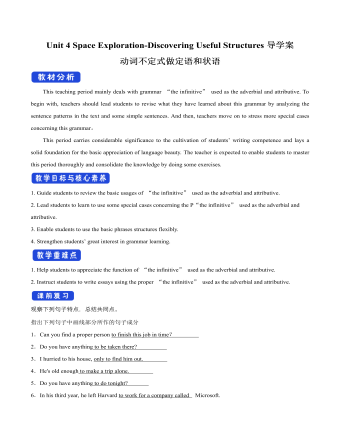
新人教版高中英语必修3Unit 4 Space Exploration-Discovering Useful Structures导学案
【点津】 1.不定式的复合结构作目的状语 ,当不定式或不定式短语有自己的执行者时,要用不定式的复合结构?即在不定式或不定式短语之前加 for +名词或宾格代词?作状语。He opened the door for the children to come in. 他开门让孩子们进来。目的状语从句与不定式的转换 英语中的目的状语从句,还可以变为不定式或不定式短语作状语,从而使句子在结构上得以简化。可分为两种情况: 1?当目的状语从句中的主语与主句中的主语相同时,可以直接简化为不定式或不定式短语作状语。We'll start early in order that/so that we may arrive in time. →We'll start early in order to/so as to arrive in time. 2?当目的状语从句中的主语与主句中的主语不相同时,要用动词不定式的复合结构作状语。I came early in order that you might read my report before the meeting. →I came early in order for you to read my report before the meeting.
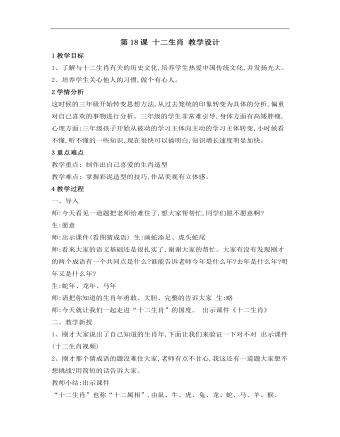
小学美术桂美版三年级上册《第18课十二生肖1》教学设计说课稿
一、导入师:今天看见一道题把老师给难住了,想大家帮帮忙,同学们愿不愿意啊?生:愿意师:出示课件(看图猜成语) 生:画蛇添足、虎头蛇尾师:看来大家的语文基础还是很扎实了,谢谢大家的帮忙。大家有没有发现刚才的两个成语有一个共同点是什么?谁能告诉老师今年是什么年?去年是什么年?明年又是什么年?生:蛇年、龙年、马年师:请把你知道的生肖年勇敢、大胆、完整的告诉大家 生:略师:今天就让我们一起走进“十二生肖”的国度。 出示课件《十二生肖》
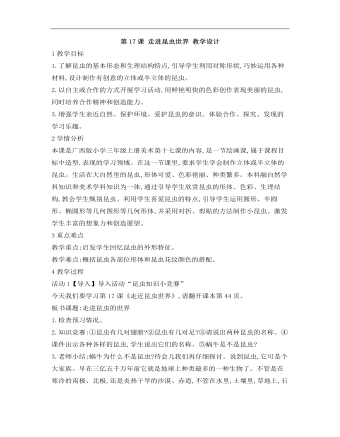
小学美术桂美版三年级上册《第17课走进昆虫世界》教学设计说课稿
2学情分析 本课是广西版小学三年级上册美术第十七课的内容,是一节绘画课,属于课程目标中造型.表现的学习领域。在这一节课里,要求学生学会制作立体或半立体的昆虫。生活在大自然里的昆虫,形体可爱、色彩艳丽、种类繁多。本科融自然学科知识和美术学科知识为一体,通过引导学生欣赏昆虫的形体、色彩、生理结构,教会学生甄别昆虫。利用学生喜爱昆虫的特点,引导学生运用圆形、半圆形、椭圆形等几何图形等几何形体,并采用对折、剪贴的方法制作小昆虫。激发学生丰富的想象力和创造愿望。
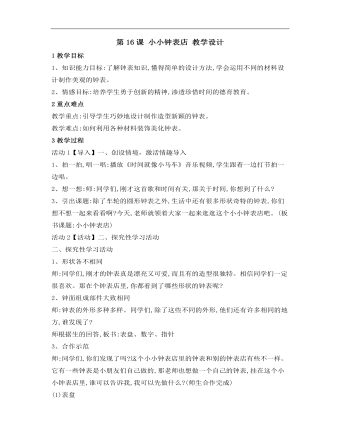
小学美术桂美版三年级上册《第16课小小钟表店1》教学设计说课稿
3教学过程活动1【导入】一、创设情境,激活情趣导入 1、拍一拍,唱一唱:播放《时间就像小马车》音乐视频,学生跟着一边打节拍一边唱。2、想一想:师:同学们,刚才这首歌和时间有关,那关于时间,你想到了什么?3、引出课题:除了车轮的圆形钟表之外,生活中还有很多形状奇特的钟表,你们想不想一起来看看啊?今天,老师就领着大家一起来逛逛这个小小钟表店吧。(板书课题:小小钟表店)
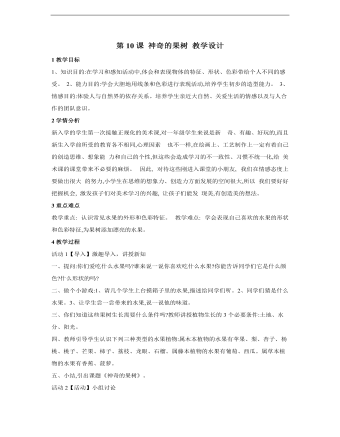
小学美术桂美版一年级上册《第10课神奇的果树》教学设计说课稿
2学情分析 新入学的学生第一次接触正规化的美术课,对一年级学生来说是新 奇、有趣、好玩的,而且新生入学前所受的教育各不相同,心理因素 也不一样,在绘画上、工艺制作上一定有着自己的创造思维、想象能 力和自己的个性,但这些会造成学习的不一致性、习惯不统一化,给 美术课的课堂带来不必要的麻烦。因此, 对待这些刚进入课堂的小朋友, 我们在情感态度上要做出很大 的努力,小学生在思维的想象力、创造力方面发展的空间很大,所以 我们要好好把握机会, 激发孩子们对美术学习的兴趣,让孩子们能发 现美,有创造美的想法。
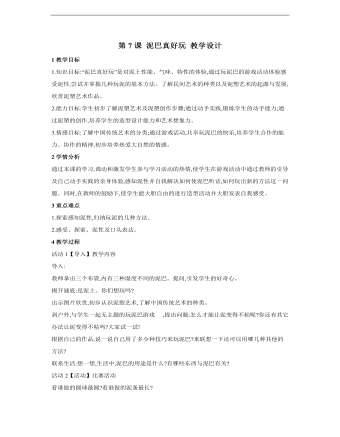
小学美术桂美版一年级上册《第7课泥巴真好玩》教学设计说课稿
2学情分析 通过本课的学习,调动和激发学生参与学习活动的热情,使学生在游戏活动中通过教师的引导及自己动手实践的亲身体验,感知泥性并自我解决如何使泥巴听话,如何玩出新的方法这一问题。同时,在教师的鼓励下,使学生能大胆自由的进行造型活动并大胆发表自我感受。3重点难点 1.探索感知泥性,归纳玩泥的几种方法。2.感受、探索、泥性及口头表达。
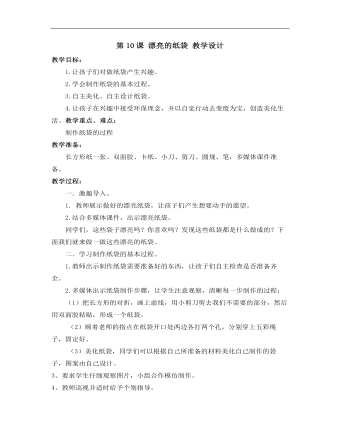
小学美术桂美版三年级上册《第10课漂亮的纸袋》教学设计说课稿
一.激趣导入。 1. 教师展示做好的漂亮纸袋,让孩子们产生想要动手的愿望。 2.结合多媒体课件,出示漂亮纸袋。 同学们,这些袋子漂亮吗?你喜欢吗?发现这些纸袋都是什么做成的?下面我们就来做一做这些漂亮的纸袋。 二.学习制作纸袋的基本过程。 1.教师出示制作纸袋需要准备好的东西,让孩子们自主检查是否准备齐全。 2.多媒体出示纸袋制作步骤,让学生注意观察,清晰每一步制作的过程: (1)把长方形的对折,画上虚线,用小剪刀剪去我们不需要的部分,然后用双面胶粘贴,形成一个纸袋。
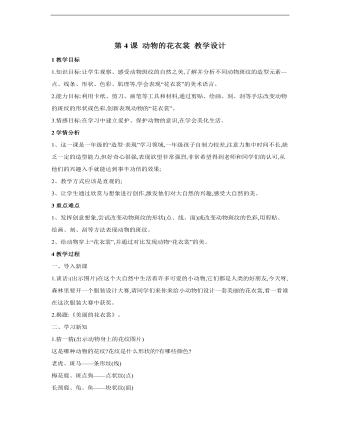
小学美术桂美版一年级上册《第4课动物的花衣裳》教学设计说课稿
2学情分析 1、这一课是一年级的“造型·表现”学习领域,一年级孩子自制力较差,注意力集中时间不长,缺乏一定的造型能力,但好奇心很强,表现欲望非常强烈,非常希望得到老师和同学们的认可,从他们的兴趣入手就能达到事半功倍的效果;2、教学方式应该是直观的;3、让学生通过欣赏与想象进行创作,激发他们对大自然的兴趣,感受大自然的美。
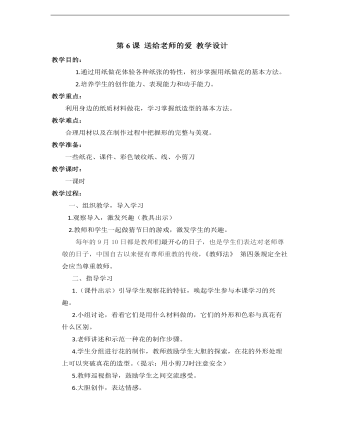
小学美术桂美版一年级上册《第6课送给老师的爱》教学设计说课稿
教学过程:一、组织教学,导入学习1.观察导入,激发兴趣(教具出示)2.教师和学生一起做猜节日的游戏,激发学生的兴趣。 每年的9月10日都是教师们最开心的日子,也是学生们表达对老师尊敬的日子,中国自古以来便有尊师重教的传统,《教师法》 第四条规定全社会应当尊重教师。
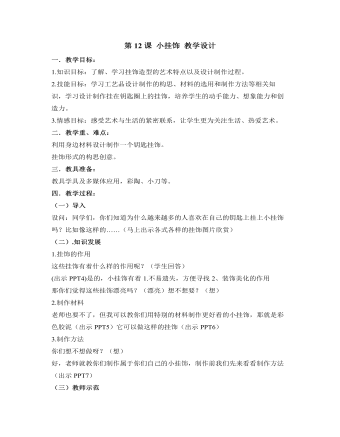
小学美术桂美版三年级上册《第12课小挂饰3》教学设计说课稿
二.教学重、难点:利用身边材料设计制作一个钥匙挂饰。挂饰形式的构思创意。三.教具准备:教具学具及多媒体应用,彩陶、小刀等。四.教学过程:(一)导入设问:同学们,你们知道为什么越来越多的人喜欢在自己的钥匙上挂上小挂饰吗?比如像这样的……(马上出示各式各样的挂饰图片欣赏)
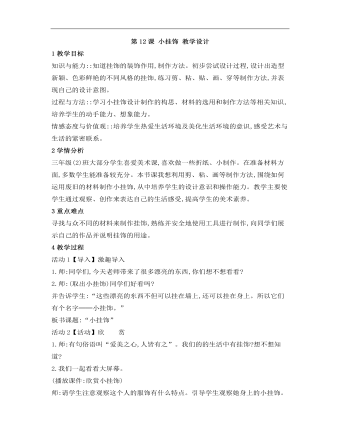
小学美术桂美版三年级上册《第12课小挂饰1》教学设计说课稿
2学情分析三年级(2)班大部分学生喜爱美术课,喜欢做一些折纸、小制作。在准备材料方面,多数学生能准备较充分。本节课我想利用剪、粘、画等制作方法,围绕如何运用废旧的材料制作小挂饰,从中培养学生的设计意识和操作能力。教学主要使学生通过观察、创作来表达自己的生活感受,提高学生的美术素养。3重点难点寻找与众不同的材料来制作挂饰,熟练并安全地使用工具进行制作,向同学们展示自己的作品并说明挂饰的用途。

